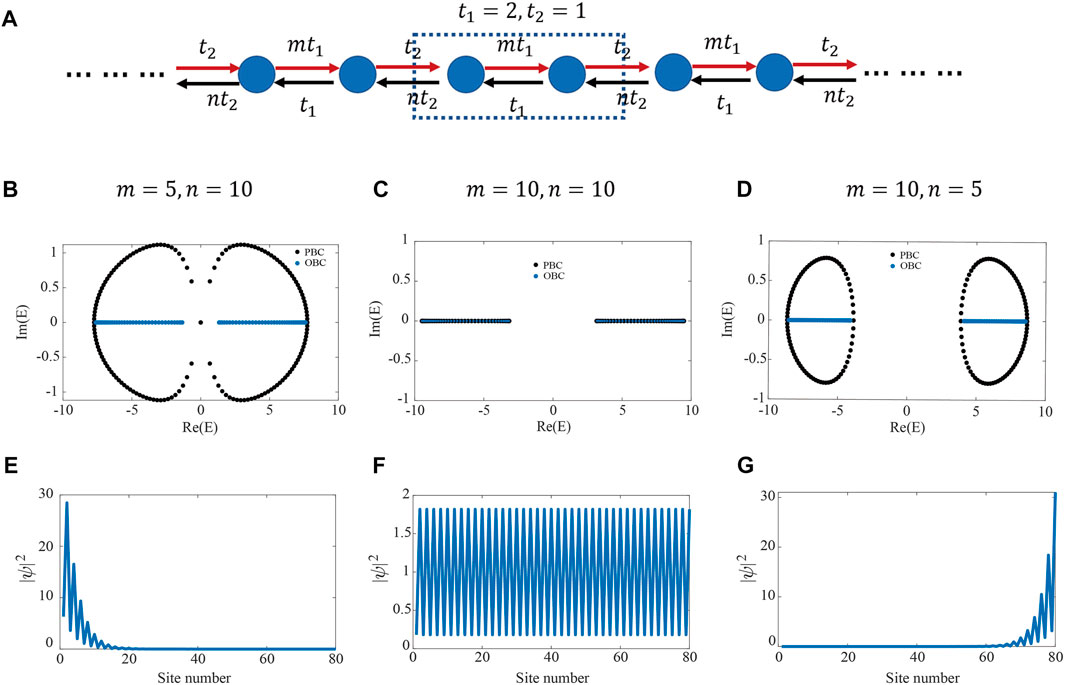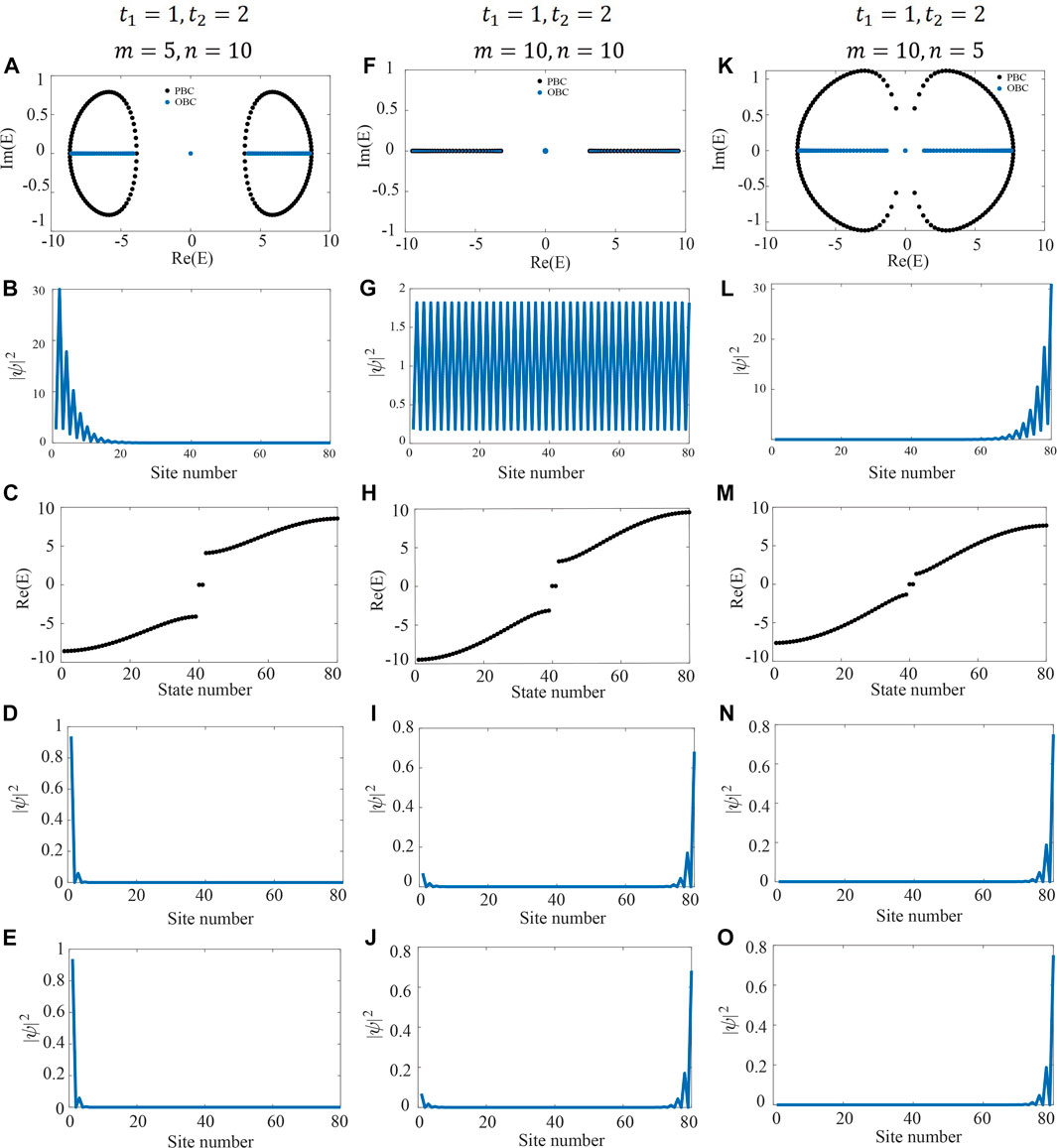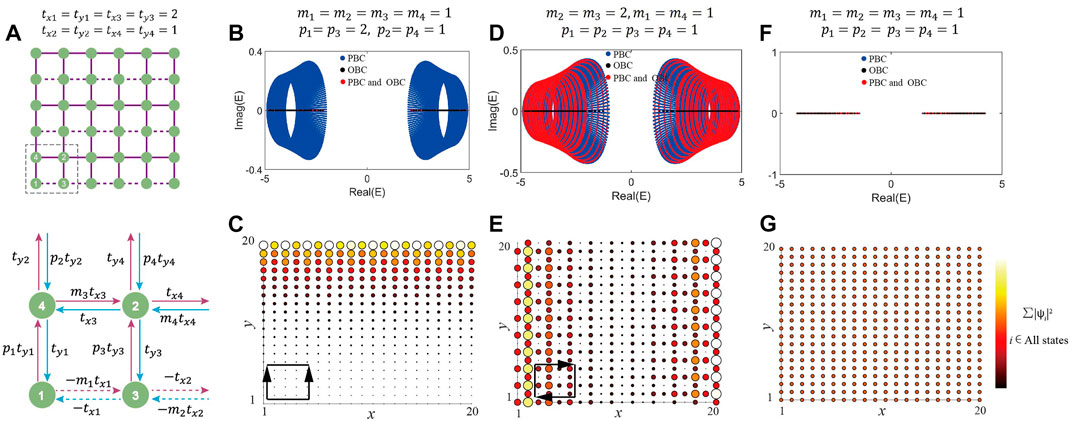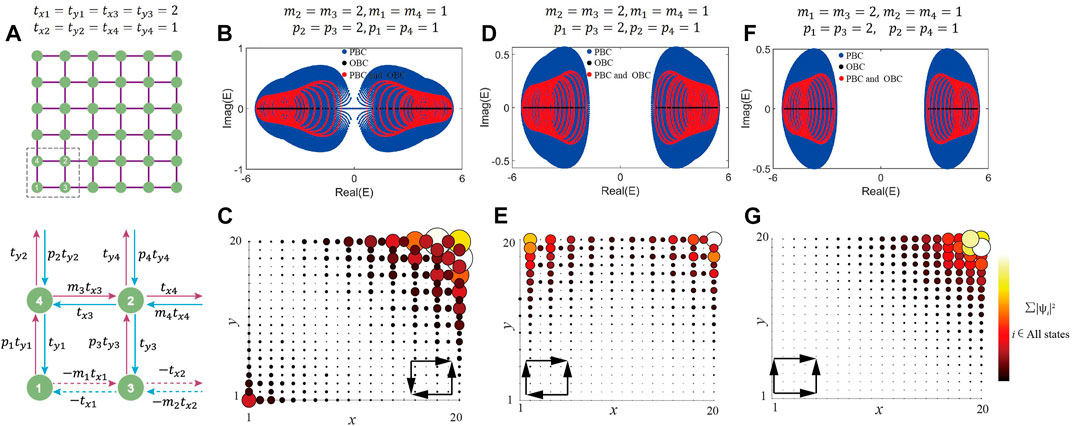
94% of researchers rate our articles as excellent or good
Learn more about the work of our research integrity team to safeguard the quality of each article we publish.
Find out more
ORIGINAL RESEARCH article
Front. Phys., 14 February 2023
Sec. Condensed Matter Physics
Volume 11 - 2023 | https://doi.org/10.3389/fphy.2023.1123596
The flourishment of non-Hermitian topology has promoted the development of skin effect, a well-known feature of the non-Hermitian systems, by which the bulk states evolve from extended to localized toward boundaries. However, in previous works, the scenarios are usually delicately designed with intricate parameters to explore the skin effects. In this work, we propose a simple paradigm to implement tunable non-Hermitian skin effects in one and two-dimensional Su-Schrieffer-Heeger (SSH)-like tight-binding models. Skin modes with distinct dimensions can be predicted irrespective of the non-Hermitian systems are topological or not. They also have no relations with the coupling values, but only are dependent on the scaling factors of non-reciprocal hopping terms. Furthermore, by engineering the hopping configurations, the skin modes could be predicted at expected edges or corners, featuring skin effects hierarchical. These tunable non-Hermitian skin effects and higher-dimensional non-Hermitian skin effects can be exploited to guide waves into targeted regions and may have useful applications when realized in metamaterials.
The most remarkable hallmark of topological phases of matter is the scattering-free transportation behavior dictated by the topological properties of bulk bands [1, 2]. In non-Hermitian systems, bulk states also become localized, resulting in the breakdown of conventional bulk-edge correspondence. Hence, edge properties cannot be dictated by their bulks any more. In non-Hermitian systems, eigenenergy of bulk bands own real and imaginary values simultaneously. And their eigenvectors are not mutually orthogonal any more. These intriguing characters prompt non-Bloch band theory in energy-nonconservative systems. Based on the non-Hermitian band theory, many exotic phenomena can be well resolved with skin effects for example, which are usually implemented by introducing asymmetry couplings [3–23] or onsite gain and loss [24–36]. A variety of works [5, 11, 16, 17, 19, 20, 31, 34, 36] have been dedicated to the exploration of skin modes and non-Hermitian topological properties in non-Hermitian systems during the past decade. Recently, [17] theoretically proposed a new mechanism defined as hybrid skin topological principle to achieve skin modes, which are induced by the intricate interplay of non-Hermitian topology and net non-reciprocal pumping. Furthermore, [3] experimentally studied the transformation of topological states from localized to extended resort to the non-Hermitian skin modes. The intriguing phenomena have also been verified in an active mechanical experiment. More recently, Zeng et al. found energy-dependent skin modes in one-dimensional (1D) system with non-reciprocal hopping beyond the nearest-neighboring sites. Inverse participation ratio was also calculated to characterize the localization of the skin localized states. In these non-Hermitian works, skin effects are mainly explored by delicately setting specific hopping amplitudes and non-Hermitian strength [3, 4, 8, 16–18, 20, 21]. This may impede the experimental implementation at the same time due to the strict requirement of tuning fine parameters. A pressing task that how to decrease the difficulty of tuning parameters to realize skin modes then was put forward. Besides, it can easily be found that the study on skin modes in the lattice with non-reciprocity between all the nearest-neighboring (NN) lattice sites has typically been ignored and related mechanism of skin effect in these cases still remains elusive.
In this work, we study the tunable non-Hermitian skin effects (NHSE) in 1D and 2D SSH-like tight-binding models. In particular, we show that the emergence of skin effect is mainly induced by the scaling factors of unequal forward and backward hoppings for intracell and intercell terms. In our scheme, inequivalence of forward and backward hopping terms breaks the standard bulk-boundary correspondence, leading to the emergence of skin effects in 1D SSH-like lattices and higher-dimensional skin effect in 2D SSH-like lattices. It can be found that no matter the systems are in topological or trivial phase, the profiles of the skin modes are almost the same in 1D or 2D SSH-like lattice models, apart from the survival of zero-energy topological modes in the topological phase. Furthermore, the profiles of skin modes can also be tuned feasibly by judiciously reconfiguring the scaling factors configuration. With no need of delicate design of hopping amplitudes, our results provide a promising paradigm to realize NHSE, which may be potentially implemented in photonic systems [24, 37–48], phononic systems [25, 29, 32, 49–52] and electrical circuits [53–57].
We consider a general 1D SSH-like tight-binding lattice model as illustrated by the schematics in Figure 1A. And the Hamiltonian of the 1D SSH-like model in momentum space can be read as,
where

FIGURE 1. (A) Schematics of a 1D non-Hermitian SSH-like model with non-reciprocal hoppings between NN sites. Dashed rectangle encloses the unit cell. Blue dots denote sublattice sites. Leftward hoppings of intracell and intercell are represented by symbols
Moreover, the skin effect can also be directly revealed by examining the superimposed intensity profiles of all the eigenstates. In fact, the most rigorous method to affirm skin effect of the non-Hermitian systems is to check the profile of every eigenfunction of all the eigenstates. As the procedure in previous works [3, 10, 17, 32, 36], the superposition of all the eigenstates profiles can also demonstrate the phenomenology attribute of the skin effect. In Figures 1E–G, wo plot
In the following, we go on to consider the same sets of parameters

FIGURE 2. We consider three sets of
The higher-dimensional NHSE (HD-NHSE) is the counterpart of NHSE in the higher-dimensional system. In this section, we proceed by extending the 1D SSH-like model into 2D, as illustrated in Figure 3A. Through the Fourier transformation of the real-space Hamiltonian, the Hamiltonian in reciprocal space can be expressed as follows,

FIGURE 3. (A) Illustration of a 2D SSH-like lattice model with dashed box highlighting the primitive cell. The enlarged inset clearly shows the detail of non-reciprocal hoppings between NN sites. Positive and negative hoppings are denoted by solid and dashed lines. Under double PBCs (blue dots), double OBCs (black dots) and
In the remain of the main text, we set intracell hopping parameters
First, we consider a hopping configuration, as shown by the inset in Figure 3C. Net non-reciprocal pumping vanishes along
In addition to the 1D edge-toward NHSE, HD-NHSE with 2D corner-toward skin modes can also be judiciously designed and predicted by configuring the scaling factor profiles. In Figure 4, three configurations are delicately designed to induce three types of HD-NHSE with various corner-toward localized modes, including diagonally distributed skin corner modes [Figure 4C], parallelly distributed skin corner modes [Figure 4E] and isolated skin corner modes [Figure 4G]. These skin modes are generated by intersection of net non-reciprocal pumping along different directions. The energy spectra of the three settings are also numerically calculated, and respectively plotted in Figures 4B–F. Under double PBCs, the spectra consist of a number of large loops and these loops become small when

FIGURE 4. (A) Diagram of a 2D SSH-like lattice model with its primitive unit in the inset below the main panel. (B)–(C) Complex energy spectra under three different boundary conditions and HD-NHSE with skin modes at two diagonal corners. (D)–(E) Complex energy spectra and HD-NHSE with skin modes at two parallel corners. (F)–(G) Complex energy spectra and HD-NHSE with skin modes at an isolated corner. The insets inside panels (C), (E) and (G) schematically show the net non-reciprocal pumping directions.
Though similar skin modes have been realized in theoretical work [17] and observed in experiment [3]. Whereas the non-reciprocity strength in these works seriously influences the effect of skin modes. And this further imposes more stringent demand to the realization in experiment. In comparison, in our proposed scheme, the expected skin modes are mainly induced by the scaling coefficient of left- and right-toward (upper- and lower-toward) hopping terms rather than their hopping amplitudes. This would dramatically expand the parameters threshold ranges and be beneficial to the experimental implementation. Our proposal offers new theoretical route to realize skin effects and provide a blueprint to study non-Hermitian topological property, which may further inspire potential application.
In conclusion, we numerically investigated the NHSE in 1D SSH-like model and HD-NHSE in 2D SSH-like model. Here, the non-Hermiticity are introduced by the non-reciprocal hoppings of both intercell and intracell sites. Non-reciprocity inevitably contributes to the formation of non-zero net non-reciprocal pumping and result in the emergence of skin modes. Furthermore, the energy spectra and skin modes can be easily regulated by configuring the pumping pattern. Our study provides useful and feasible designs for generating controllable NHSE that can be potentially realized in various physical platforms such as electrical circuits, sonic crystals, and electromagnetic metamaterials. In addition, our findings also provide alternative degree of freedom to realize non-Hermiticity.
The raw data supporting the conclusion of this article will be made available by the authors, without undue reservation.
All authors listed have made a substantial, direct, and intellectual contribution to the work and approved it for publication.
The authors acknowledge support from National Natural Science Foundation of China (Grant Nos. 12074281 and 12047541), the Jiangsu specially appointed professor funding, and the Academic Program Development of Jiangsu Higher Education (PAPD).
The authors declare that the research was conducted in the absence of any commercial or financial relationships that could be construed as a potential conflict of interest.
All claims expressed in this article are solely those of the authors and do not necessarily represent those of their affiliated organizations, or those of the publisher, the editors and the reviewers. Any product that may be evaluated in this article, or claim that may be made by its manufacturer, is not guaranteed or endorsed by the publisher.
1. Hasan MZ, Kane CL. Colloquium: Topological insulators. Rev Mod Phys (2010) 82:3045–67. doi:10.1103/revmodphys.82.3045
2. Qi X, Zhang S. Topological insulators and superconductors. Rev Mod Phys (2011) 83:1057–110. doi:10.1103/revmodphys.83.1057
3. Wang W, Wang X, Ma G. Non-Hermitian morphing of topological modes. Nature (2022) 608:50–5. doi:10.1038/s41586-022-04929-1
4. Long Y, Xue H, Zhang B. Non-Hermitian topological systems with eigenvalues that are always real. Phys Rev B (2022) 105:L100102. doi:10.1103/physrevb.105.l100102
5. Zeng Q. Non-Hermitian skin effect edge. Phys Rev B (2022) 106:235411. doi:10.1103/physrevb.106.235411
7. Zhang L, Yang Y, Ge Y, Guan Y, Chen Q, Yan Q, et al. Acoustic non-Hermitian skin effect from twisted winding topology. Nat Commun (2021) 12:6297. doi:10.1038/s41467-021-26619-8
8. Yu Y, Shvets G. Zero-energy corner states in a non-Hermitian quadrupole insulator. Phys Rev B (2020) 103:L041102. doi:10.1103/physrevb.103.l041102
9. Song Y, Liu W, Zheng L, Zhang Y, Wang B, Lu P. Two-dimensional non-hermitian skin effect in a synthetic photonic lattice. Phys Rev Appl (2020) 14:064076. doi:10.1103/physrevapplied.14.064076
11. Kawabata K, Sato M, Shiozaki K. Higher-order non-Hermitian skin effect. Phys Rev B (2020) 102:205118. doi:10.1103/physrevb.102.205118
12. Edvardsson E, Kunst FK, Bergholtz EJ. Non-Hermitian extensions of higher-order topological phases and their biorthogonal bulk-boundary correspondence. Phys Rev B (2019) 99:081302. doi:10.1103/physrevb.99.081302
13. Yokomizo K, Murakami S. Non-bloch band theory of non-hermitian systems. Phys Rev Lett (2019) 123:066404. doi:10.1103/physrevlett.123.066404
14. Wang P, Jin L, Song Z. Non-Hermitian phase transition and eigenstate localization induced by asymmetric coupling. Phys Rev A (2019) 99:062112. doi:10.1103/physreva.99.062112
15. Imura K, Takane Y. Generalized bulk-edge correspondence for non-Hermitian topological systems. Phys Rev B (2019) 100:165430. doi:10.1103/physrevb.100.165430
16. Deng T, Yi W. Non-Bloch topological invariants in a non-Hermitian domain wall system. Phys Rev B (2019) 100:035102. doi:10.1103/physrevb.100.035102
17. Lee CH, Li L, Gong J. Hybrid higher-order skin-topological modes in nonreciprocal systems. Phys Rev Lett (2019) 123:016805. doi:10.1103/physrevlett.123.016805
18. Liu T, Zhang Y, Ai Q, Gong Z, Kawabata K, Ueda M, et al. Second-Order topological phases in non-hermitian systems. Phys Rev Lett (2019) 122:076801. doi:10.1103/physrevlett.122.076801
19. Lee CH, Thomale R. Anatomy of skin modes and topology in non-Hermitian systems. Phys Rev B (2019) 99:201103. doi:10.1103/physrevb.99.201103
21. Yao S, Wang Z. Edge states and topological invariants of non-hermitian systems. Phys Rev Lett (2018) 121:086803. doi:10.1103/physrevlett.121.086803
22. Lieu S. Topological phases in the non-Hermitian Su-Schrieffer-Heeger model. Phys Rev B (2018) 97:045106. doi:10.1103/physrevb.97.045106
23. Kunst FK, Edvardsson E, Budich JC, Bergholtz EJ. Biorthogonal bulk-boundary correspondence in non-hermitian systems. Phys Rev Lett (2018) 121:026808. doi:10.1103/physrevlett.121.026808
24. Weimann S, Kremer M, Plotnik Y, Lumer Y, Nolte S, Makris KG, et al. Topologically protected bound states in photonic parity–time-symmetric crystals. Nat Mater (2017) 16:433–8. doi:10.1038/nmat4811
25. Zhang Z, Rosendo LM, Cheng Y, Liu X, Christensen J. Non-hermitian sonic second-order topological insulator. Phys Rev Lett (2019) 122:195501. doi:10.1103/physrevlett.122.195501
26. Parto M, Liu YGN, Bahari B, Khajavikhan M, Christodoulides DN. Non-hermitian and topological photonics: Optics at an exceptional point. Nanophotonics (2020) 10:403–23. doi:10.1515/nanoph-2020-0434
27. Zhang Q, Xu W, Wang Z, Zhang G. Non-Hermitian effects of the intrinsic signs in topologically ordered wavefunctions. Commun Phys (2020) 3:209. doi:10.1038/s42005-020-00479-y
28. Reséndiz-Vázquez P, Tschernig K, Perez-Leija A, Busch K, León-Montiel RDJ. Topological protection in non-Hermitian Haldane honeycomb lattices. Phys Rev Res (2020) 2:013387. doi:10.1103/physrevresearch.2.013387
29. Gao H, Xue H, Wang Q, Gu Z, Liu T, Zhu J, et al. Observation of topological edge states induced solely by non-Hermiticity in an acoustic crystal. Phys Rev B (2020) 101:180303. doi:10.1103/physrevb.101.180303
30. Li L, Lee CH, Gong J. Topological switch for non-hermitian skin effect in cold-atom systems with loss. Phys Rev Lett (2020) 124:250402. doi:10.1103/physrevlett.124.250402
31. Yi Y, Yang Z. Non-hermitian skin modes induced by on-site dissipations and chiral tunneling effect. Phys Rev Lett (2020) 125:186802. doi:10.1103/physrevlett.125.186802
32. Gao H, Xue H, Gu Z, Liu T, Zhu J, Zhang B. Non-Hermitian route to higher-order topology in an acoustic crystal. Nat Commun (2021) 12:1888. doi:10.1038/s41467-021-22223-y
33. Wu HC, Jin L, Song Z. Topology of an anti-parity-time symmetric non-Hermitian Su-Schrieffer-Heeger model. Phys Rev B (2021) 103:235110. doi:10.1103/physrevb.103.235110
34. Zhang X, Tian Y, Jiang J, Lu M, Chen Y. Observation of higher-order non-Hermitian skin effect. Nat Commun (2021) 12:5377. doi:10.1038/s41467-021-25716-y
35. Li Y, Liang C, Wang C, Lu C, Liu Y. Gain-loss-induced hybrid skin-topological effect. Phys Rev Lett (2022) 128:223903. doi:10.1103/physrevlett.128.223903
36. Zhu W, Gong J. Hybrid skin-topological modes without asymmetric couplings. Phys Rev B (2022) 106:035425. doi:10.1103/physrevb.106.035425
37. Guo A, Salamo GJ, Duchesne D, Morandotti R, Volatier-Ravat M, Aimez V, et al. Observation ofPT-symmetry breaking in complex optical potentials. Phys Rev Lett (2009) 103:093902. doi:10.1103/physrevlett.103.093902
39. Hodaei H, Miri M, Heinrich M, Christodoulides DN, Khajavikhan M. Parity-time–symmetric microring lasers. Science (2014) 346:975–8. doi:10.1126/science.1258480
40. Peng B, Özdemir SK, Lei F, Monifi F, Gianfreda M, Long GL, et al. Parity–time-symmetric whispering-gallery microcavities. Nat Phys (2014) 10:394–8. doi:10.1038/nphys2927
41. Zeuner JM, Rechtsman MC, Plotnik Y, Lumer Y, Nolte S, Rudner MS, et al. Observation of a topological transition in the bulk of a non-hermitian system. Phys Rev Lett (2015) 115:040402. doi:10.1103/physrevlett.115.040402
43. Song W, Sun W, Chen C, Song Q, Xiao S, Zhu S, et al. Breakup and recovery of topological zero modes in finite non-hermitian optical lattices. Phys Rev Lett (2019) 123:165701. doi:10.1103/physrevlett.123.165701
44. Zhang SM, Jin L. Flat band in two-dimensional non-Hermitian optical lattices. Phys Rev A (2019) 100:043808. doi:10.1103/physreva.100.043808
45. Kremer M, Biesenthal T, Maczewsky LJ, Heinrich M, Thomale R, Szameit A. Demonstration of a two-dimensional $${\cal P}{\cal T}$$-symmetric crystal. Nat Commun (2019) 10:435. doi:10.1038/s41467-018-08104-x
46. Ao Y, Hu X, You Y, Lu C, Fu Y, Wang X, et al. Topological phase transition in the non-hermitian coupled resonator array. Phys Rev Lett (2020) 125:013902. doi:10.1103/physrevlett.125.013902
47. Wu Y, Liu C, Hou J. Wannier-type photonic higher-order topological corner states induced solely by gain and loss. Phys Rev A (2020) 101:043833. doi:10.1103/physreva.101.043833
48. Wu S, Jiang B, Liu Y, Jiang J. All-dielectric photonic crystal with unconventional higher-order topology. Photon Res (2021) 9:668. doi:10.1364/prj.418689
49. Tang W, Jiang X, Ding K, Xiao Y, Zhang Z, Chan CT, et al. Exceptional nexus with a hybrid topological invariant. Science (2020) 370:1077–80. doi:10.1126/science.abd8872
50. Gu Z, Gao H, Cao P, Liu T, Zhu X, Zhu J. Controlling sound in non-hermitian acoustic systems. Phys Rev Appl (2021) 16:057001. doi:10.1103/physrevapplied.16.057001
51. Tang W, Ding K, Ma G. Direct measurement of topological properties of an exceptional parabola. Phys Rev Lett (2021) 127:034301. doi:10.1103/physrevlett.127.034301
52. Wu S, Lin Z, Jiang B, Zhou X, Hang ZH, Hou B, et al. Higher-order topological states in acoustic twisted moiré superlattices. Phys Rev Appl (2022) 17:034061. doi:10.1103/physrevapplied.17.034061
53. Ezawa M. Non-Hermitian higher-order topological states in nonreciprocal and reciprocal systems with their electric-circuit realization. Phys Rev B (2019) 99:201411. doi:10.1103/physrevb.99.201411
54. Zeng Q, Yang Y, Xu Y. Topological phases in non-Hermitian Aubry-André-Harper models. Phys Rev B (2020) 101:020201. doi:10.1103/physrevb.101.020201
55. Helbig T, Hofmann T, Imhof S, Abdelghany M, Kiessling T, Molenkamp LW, et al. Generalized bulk–boundary correspondence in non-Hermitian topolectrical circuits. Nat Phys (2020) 16:747–50. doi:10.1038/s41567-020-0922-9
56. Liu S, Ma S, Yang C, Zhang L, Gao W, Xiang YJ, et al. Gain- and loss-induced topological insulating phase in a non-hermitian electrical circuit. Phys Rev Appl (2020) 13:014047. doi:10.1103/physrevapplied.13.014047
58. Kawabata K, Higashikawa S, Gong Z, Ashida Y, Ueda M. Topological unification of time-reversal and particle-hole symmetries in non-Hermitian physics. Nat Commun (2019) 10:297. doi:10.1038/s41467-018-08254-y
Keywords: skin effect, non-reciprocal hopping, tight-binding model, complex energy plane, non-hermitian
Citation: Wu S-Q, Xu Y and Jiang J-H (2023) Tunable non-Hermitian skin effects in Su-Schrieffer-Heeger-like models. Front. Phys. 11:1123596. doi: 10.3389/fphy.2023.1123596
Received: 14 December 2022; Accepted: 24 January 2023;
Published: 14 February 2023.
Edited by:
Constantinos Simserides, National and Kapodistrian University of Athens, GreeceReviewed by:
Paolo Moretti, University of Erlangen Nuremberg, GermanyCopyright © 2023 Wu, Xu and Jiang. This is an open-access article distributed under the terms of the Creative Commons Attribution License (CC BY). The use, distribution or reproduction in other forums is permitted, provided the original author(s) and the copyright owner(s) are credited and that the original publication in this journal is cited, in accordance with accepted academic practice. No use, distribution or reproduction is permitted which does not comply with these terms.
*Correspondence: Shi-Qiao Wu, d3VzaGlxaWFvNDU3MEBnbWFpbC5jb20=
Disclaimer: All claims expressed in this article are solely those of the authors and do not necessarily represent those of their affiliated organizations, or those of the publisher, the editors and the reviewers. Any product that may be evaluated in this article or claim that may be made by its manufacturer is not guaranteed or endorsed by the publisher.
Research integrity at Frontiers

Learn more about the work of our research integrity team to safeguard the quality of each article we publish.